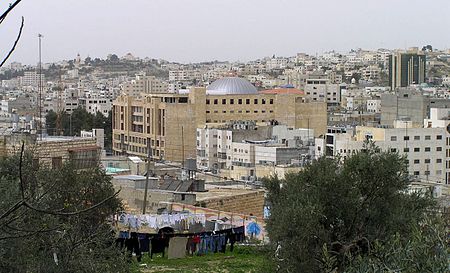Hebron

Hebron (Arabic: الخليل al-Khalīl, or خَلِيل الرَّحْمَن Khalīl al-Raḥmān; Hebrew: חֶבְרוֹן Ḥevrōn, ) is a Palestinian city in the southern West Bank, 30 kilometres (19 mi) south of Jerusalem. Nestled in the Judaean Mountains, it lies 930 metres (3,050 ft) above sea level. The second-largest city in the West Bank (after East Jerusalem), and the third-largest in the Palestinian territories (after East Jerusalem and Gaza), it had a population of 201,063 Palestinians in 2017, and seven hundred Jewish settlers concentrated on the outskirts of its Old City. It includes the Cave of the Patriarchs, which Jewish, Christian, and Islamic traditions all designate as the burial site of three key patriarchal/matriarchal couples. The city is often considered one of the four holy cities in Judaism as well as in Islam.Hebron is considered one of the oldest cities in the Levant. According to the Bible, Abraham settled in Hebron and bought the Cave of the Patriarchs as a burial place for his wife Sarah. Biblical tradition holds that the patriarchs Abraham, Isaac, and Jacob, along with their wives Sarah, Rebecca, and Leah, were buried in the cave. Hebron is also recognized in the Bible as the place where David was anointed king of Israel. Following the Babylonian captivity, the Edomites settled in Hebron. During the first century BCE, Herod the Great built the wall which still surrounds the Cave of the Patriarchs, which later became a church, and then a mosque. With the exception of a brief Crusader control, successive Muslim dynasties ruled Hebron from the 6th century CE until the Ottoman Empire's dissolution following World War I, when the city became part of British Mandatory Palestine. A massacre in 1929 and the Arab uprising of 1936–39 led to the emigration of the Jewish community from Hebron. The 1948 Arab–Israeli War saw the entire West Bank, including Hebron, occupied and annexed by Jordan, and since the 1967 Six-Day War, the city has been under Israeli military occupation. Following Israeli occupation, Jewish presence was reestablished at the city. Since the 1997 Hebron Protocol, most of Hebron has been governed by the Palestinian National Authority. The city is often described as a "microcosm" of the Israeli-Palestinian conflict and the Israeli occupation of the West Bank. The Hebron Protocol of 1997 divided the city into two sectors: H1, controlled by the Palestinian National Authority, and H2, roughly 20% of the city, including 35,000 Palestinians, under Israeli military administration. All security arrangements and travel permits for local residents are coordinated between the Palestinian National Authority and Israel via the Israeli military administration of the West Bank (COGAT). The Jewish settlers have their own governing municipal body, the Committee of the Jewish Community of Hebron. Today, Hebron is the capital of the Hebron Governorate, the largest governorate of the State of Palestine, with an estimated population of around 782,227 as of 2021. It is a busy hub of West Bank trade, generating roughly a third of the area's gross domestic product, largely due to the sale of limestone from quarries in its area. It has a local reputation for its grapes, figs, limestone, pottery workshops and glassblowing factories. The old city of Hebron features narrow, winding streets, flat-roofed stone houses, and old bazaars. The city is home to Hebron University and the Palestine Polytechnic University.
Excerpt from the Wikipedia article Hebron (License: CC BY-SA 3.0, Authors, Images).Hebron
Jerusalem Rd., Hebron Old City
Geographical coordinates (GPS) Address Nearby Places Show on map
Geographical coordinates (GPS)
| Latitude | Longitude |
|---|---|
| N 31.528611111111 ° | E 35.096944444444 ° |
Address
شارع الملك عبد الله
Jerusalem Rd.
150 Hebron, Old City
Palestinian Territories
Open on Google Maps







